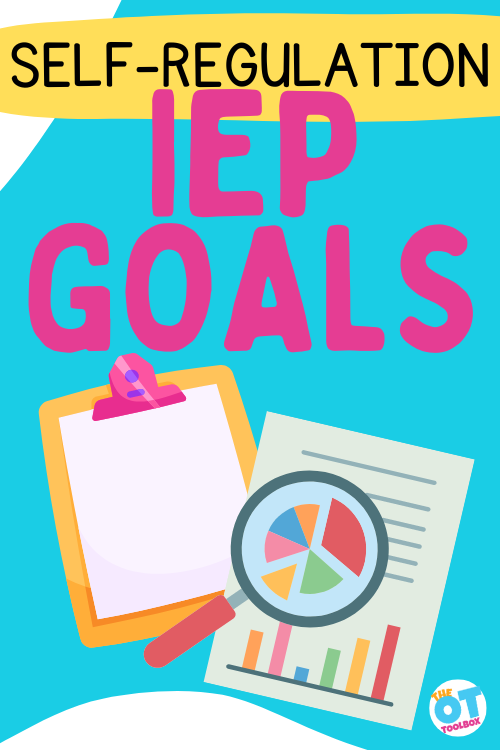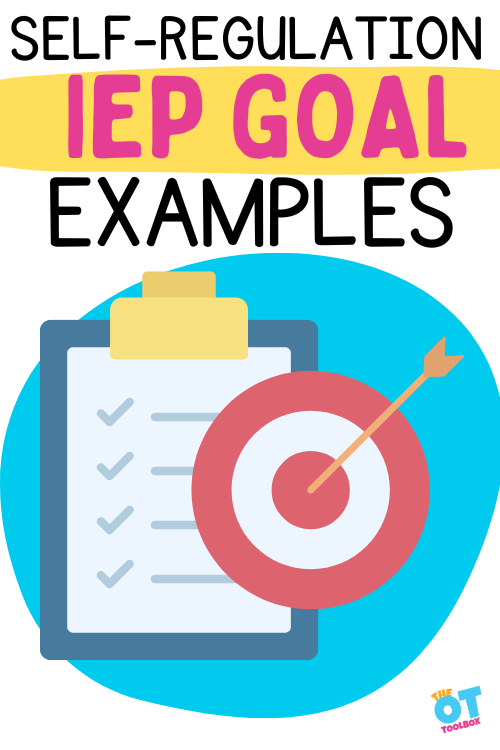Writing IEP goals, (especially IEP goals for self-regulation needs) can be tricky. The tricky part is knowing what to measure, and how to measure it. In this post we will review IEP Goals for Self Regulation. Sensory goals are especially difficult to write and measure as they are often dealing with behaviors instead of skills. It is easy to formulate a snipping with scissors goal, or stacking cubes, as they are easily measured. Not so much for the IEP goals for self regulation. Check out the OT Toolbox archives for more self regulation strategies.

Writing IEP Goals for Self Regulation
If you ask parents or teachers what behavioral improvements they would like to see in their students, they often give a broad idea; “I would like them to behave in class”; “I want them to learn”; “I want them to be like the other kids.”
We all do.
That is not the question, nor is it a measurable goal that would show up on an IEP or 504 plan.
The question is how do we get there, what does self-regulation look like now (how are regulation needs impacting learning and participation in the school environment?) where is the child in social emotional development by stage, and what will it look like when this student achieves this goal?
SMART IEP Goals for Self-Regulation
Before talking about writing IEP goals for self regulation, we need to review the basics of writing good goals. Anyone can write a goal, but is it SMART? Like any IEP goal, they need to be SMART as we have reviewed in previous posts.
- S: specific – did you detail what it is you want to achieve?
- M: measurable – how are you going to measure success?
- A: is this goal attainable or too lofty?
- R: is this goal realistic?
- T: timebound – Do you have a set timeframe for this goal to be measured?
First decide if the goals are SMART. Are the goals specific and measurable, or too general? Are they actually attainable and relevant?
Four traps to goal success:
- People don’t set clear goals
- They feel discouraged
- They feel overwhelmed
- They are not ready to change
The examples above are not SMART. You will find yourself at the next IEP meeting saying you sort of made progress, and things are kind of better. Mostly you will be confused about their current level of function, and feel like a failure for not being able to document it effectively.
Self-Regulation Goal Example one: I want him to be normal like the other kids.
- Specific – what is “normal”? How do the other kids act that you are trying to get your student to emulate?
- Measurable – because we can’t really define normal, how can we measure it? How will you know he is more “normal” than last month?
- Attainable: Is this student who can not sit in class for 30 seconds going to behave like typical students by the end of the IEP period? Probably not yet. Maybe not ever. Setting too lofty of a goal does not look great for the student or their therapist. It is better to break down the goal into more attainable pieces
- Realistic: Is this student with a diagnosis of X,Y or Z going to be like neurotypical peers even with all the right intervention? In some cases yes, but more often they will be better, but not typical
- Timebound: IEPs inherently have time frames. This one is easy. Do you want to just set one goal for a year, or have smaller objectives to measure as well?
How can you use these factors to create a self-regulation IEP goal for the student that can be more specific, measured, achieved, is realistic, and by a certain point in time?
Self-Regulation Goal Example two: I want them to behave in class.
- Specific: what does “behave” look like? Your idea of great behavior might look different than the teacher’s expectations. This is the same as telling your child to be good in school. It is too general.
- Measurable: without defining what “behave” is, how will you know if you have achieved it?
- Attainable: maybe, but you won’t know because it is not specific or measurable. It might be attainable to achieve better behavior in a year, but if they are significantly impaired or young, they might not be able to reach this lofty goal.
- Realistic: again it might be, depending on the student and the expectations. Without specifics, it is hard to tell.
- Timebound: based on the nature of IEP parameters, 12 months is probably set into the goal.
How can you create a self-regulation IEP goal on regulation-based behavior that is specific, measured, achieved, is realistic, and by a certain point in time?
Let’s break this down into more specifics and then come up with some great self-regulation IEP goal examples…
How to write IEP goals for self regulation
In general, we all want our students to behave in class and act like typical children. How can you write a measurable SMART goal that works toward these goals?
By (Date), student will demonstrate improved self regulation skills by attending to a teacher directed task for 3 minutes with less than 4 redirections back to the task from a baseline of one minute as measured by occupational therapist and/or teacher.
- S: attending for 3 minutes with less than 4 redirections, from a baseline of one minute
- M: number of minutes, number of redirections, behavior: attend
- A: three minutes is not a long time to work toward if the current time is one minute. Four redirections in that time is generous
- R: For this particular student it is realistic
- T: specific date is mentioned
By (Date) student will improve self regulation by following teacher instructions 50% of the time without maladaptive reactions including hitting, biting, refusal, crying, or elopement from a baseline of 25% as measured by occupational therapist and/or teacher.
- S: follow teacher instructions 75% of the time without maladaptive reactions such as….
- M: percentage of class time, evidence of behaviors
- A: hopefully. This particular student needs to improve compliance from 25-50%. It could say from 25-30%, or whatever progress you believe is attainable
- R: if the goal is written accurately, it should be realistic that this student can achieve it
- T: yes

self regulation iep goals examples
Next, we put what we know from reading the process above to create a process. Use the SMART process to target any emotional regulation need. Some self regulation iep goals examples include…
By (date) student will improve self regulation by following completing a non preferred 4 minute task without maladaptive reactions including hitting, biting, refusal, crying, or elopement from a baseline of 2 minutes as measured by occupational therapist and/or teacher.
In this goal we are specifically tracking the behavior. Notice it does not say anything about how much assistance, seating options, adaptations, cues, or what the task is. You can add those to make it more specific, or leave as a general goal just to work on compliance
By (date) student will improve self regulation by selecting a calm down option from a field of three when presented with choices 50% of trials from a baseline of 20%….. You can modify this goal by:
- student will alert teacher that they need a sensory break X% of the time they are having a meltdown
- Student will recognize that they are out of sync and ask for a specific sensory break X% of time
- The student will pick an appropriate calm down option from the provided 10 cards 75% of trials. You can decide if all of the options are appropriate, or there are some that are irrelevant in order to improve accuracy (add eat broccoli, or something that the student most likely does not want)
- When visibly demonstrating maladaptive behaviors (crying, biting, self injury, hitting) student will touch picture cards on desk to indicate a sensory break, three of five trials
- Use words to say they are upset/sad/angry instead of biting or hitting others more than 3x daily from a baseline of zero
- Reduce maladaptive behavioral reactions in a one hour time slot 50% from 10 to 5 or less.
These goals take time to measure to get a baseline and gather data. When negative behaviors are present, monitoring and measurement is critical. Otherwise it feels like the behaviors are not getting any better, when in fact they might be.
More measurable self regulation IEP objectives
- Stay on 2 foot carpet square for X minutes with less than x redirections back to spot
- Remain in seat during X minute activity without eloping more than x times
- Sit in a group activity for X minutes, touching peers less than X times
- Complete a provided fine motor activity with less than 5 reminders back to task
- Calm down from upset within 5 minutes of start (with or without sensory strategies)
- Participate in a group task for X minutes with less than 4 maladaptive responses, such as touching others, aggression, destruction of property, or outbursts
Other Ideas for IEP Goals for Self Regulation
Rather than specifically targeting self-regulation, part of the underlying components are social emotional skills. You can foster self-regulation by targeting the various components of emotional regulation. We cover these areas in specifics in our blog post titled, social skills checklist. Consider the areas of social emotional development:
- Conversational Skills
- Interpersonal Skills
- Emotional Skills
- Social Play
- Emotional Development
- Emotional Regulation
- Peer Interactions
- Self-Awareness Skills
- Self-Confidence
- Social Awareness
- Self-Management
- Relationship Skills
- Responsible Decision Making
There are many other ways to target self-regulation skills in interventions. Some of these interventions can be identified in self-regulation IEP goals, depending on the needs of the individual:
- Consider the individual. Check out our list of student strengths for IEP writing.
- Pick one or two target behaviors you want to reduce or add to a plan.
- Consider social emotional learning as a class-wide or school-wide concept.
- Decide what you want them to do, that they are not doing now (following directions, attending to task). Usually the behavior is preventing them from participating in some way.
- Figure out how to measure this goal. Will you have a chart, a timer for 30 minute intervals, just measured during your therapy sessions, or over the span of a week?
- Make small adjustments in behavior. Many children are not going to comply overnight. It is better to make small adjustments, then modify them, rather than setting lofty goals that are not met.
- Add in sensory supports if needed – given adaptive seating, weighted vest, headphones, sensory breaks every three minutes, etc. I add a list of these possible accommodations in the IEP. “sensory supports as deemed effective including x,y,z. I keep these broad as I generally don’t have a magic formula of what is going to work each time.
- Decide if you are focusing on the behavior, the task, or both. Is the goal to complete a worksheet without 17 redirections? Is it just to stay at the table?
- When creating goals, consider how you will achieve these targets. Can you include interventions such as: emotional regulation games, self-regulation books, or even parent education on co-regulation needs. Getting specific can have big results.
- Work on interventions by using a few self awareness games for building skills through play.
By taking a wider view at self-regulation and social emotional needs, we can impact learning, peer interaction, and participation in the educational environment in big ways.

Goal Writing for Pediatric Practitioners, by Krupa Panchmatiya Kuruvilla, OTR/L is available in The OT Toolbox Shop. This e-book is like having an experienced OT mentoring you as you navigate goal writing.

Victoria Wood, OTR/L is a contributor to The OT Toolbox and has been providing Occupational Therapy treatment in pediatrics for more than 25 years. She has practiced in hospital settings (inpatient, outpatient, NICU, PICU), school systems, and outpatient clinics in several states. She has treated hundreds of children with various sensory processing dysfunction in the areas of behavior, gross/fine motor skills, social skills and self-care. Ms. Wood has also been a featured speaker at seminars, webinars, and school staff development training. She is the author of Seeing your Home and Community with Sensory Eyes.






